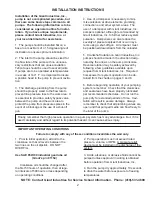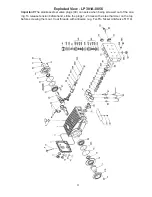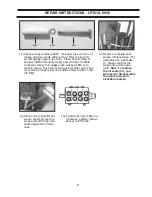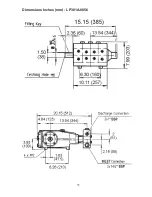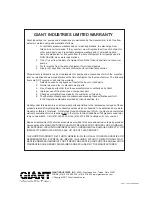
2
INSTALLATION INSTRUCTIONS
4. Use of a dampener is necessary to mini-
mize pulsation at drive elements, plumbing,
connections, and other system areas. The
use of a dampener with Giant Industries, Inc.
pumps is optional, although recommended by
Giant Industries, Inc. to further reduce system
pulsation. Dampeners can also reduce the
severity of pressure spikes that occur in sys-
tems using a shut-off gun. A dampener must
be positioned downstream from the unloader.
5. Crankshaft rotation on Giant Industries, Inc.
pumps should be made in the direction desig-
nated by the arrows on the pump crankcase.
Reverse rotation may be safely achieved by
following a few guidelines available upon
request from Giant Industries, Inc. Required
horsepower for system operation can be ob-
tained from the charts on pages 3 and 6.
6. Before beginning operation of your pumping
system, remember: Check that the crankcase
and seal areas have been properly lubricated
per recommended schedules. Do not run the
pump dry for extended periods of time. Cavi-
tation will result in severe damage. Always
remember to check that all plumbing valves are
open and that pumped media can flow freely to
the inlet of the pump.
IMPORTANT OPERATING CONDITIONS
Failure to comply with any of these conditions invalidates the warranty.
2. Pump operation must not exceed rated
pressure, volume, or RPM. A pressure relief
device must be installed in the discharge of the
system.
3. Acids, alkalines, or abrasive fluids cannot be
pumped unless approval in writing is obtained
before operation from Giant Industries, Inc.
4. Run the pump dry approximately 10 seconds
to drain the water before exposure to freezing
temperatures.
1. Prior to initial operation, add oil to the
crankcase so that oil level is between the
two lines on the oil dipstick. DO NOT
OVERFILL.
Use SAE 85W-90 industrial gear lube oil
(Giant’s p/n 01154)
Crankcase oil should be changed after
the first 50 hours of operation, then at regu
-
lar intervals of 500 hours or less depending
on operating conditions.
Installation of the Giant Industries, Inc.,
pump is not a complicated procedure, but
there are some basic steps common to all
pumps. The following information is to be
considered as a general outline for instal-
lation. If you have unique requirements,
please contact Giant Industries, Inc. or
your local distributor for assistance.
1. The pump should be installed flat on a
base to a maximum of a 15 degree angle of
inclination to ensure optimum lubrication.
2. The inlet to the pump should be sized for
the flow rate of the pump with no unneces
-
sary restrictions that can cause cavitation.
Teflon tape should be used to seal all joints.
If pumps are to be operated at temperatures
in excess of 140
0
F, it is important to insure
a positive head to the pump to prevent cavita-
tion.
3. The discharge plumbing from the pump
should be properly sized to the flow rate to
prevent line pressure loss to the work area. It
is essential to provide a safety bypass valve
between the pump and the work area to
protect the pump from pressure spikes in the
event of a blockage or the use of a shut-off
gun.
Finally, remember that high pressure operation in a pump system has many advantages. But, if it is
used carelessly and without regard to its potential hazard, it can cause serious injury.
NOTE: Contact Giant Industries for Service School Information. Phone: (419)-531-4600


